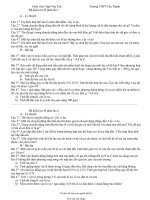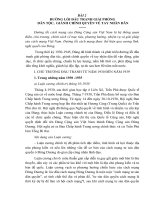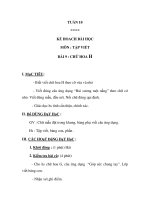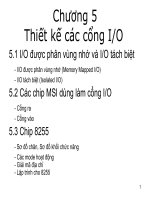World War I: Biographies doc
Bạn đang xem bản rút gọn của tài liệu. Xem và tải ngay bản đầy đủ của tài liệu tại đây (17.44 MB, 200 trang )
Biographies
World War I
WWIBIO 9/26/03 12:35 PM Page 1
Biographies
Tom Pendergast
and Sara Pendergast
Christine Slovey, Editor
World War I
WWIBIO 9/26/03 12:35 PM Page 3
Tom Pendergast and Sara Pendergast
Staff
Christine Slovey, U•X•L Senior Editor
Julie L. Carnagie, U•X•L Contributing Editor
Carol DeKane Nagel, U•X•L Managing Editor
Tom Romig, U•X•L Publisher
Pamela A.E. Galbreath, Senior Art Director (Page design)
Jennifer Wahi, Art Director (Cover design)
Shalice Shah-Caldwell, Permissions Associate (Images)
Robyn Young, Imaging and Multimedia Content Editor
Pamela A. Reed, Imaging Coordinator
Robert Duncan, Imaging Specialist
Rita Wimberly, Senior Buyer
Evi Seoud, Assistant Manager, Composition Purchasing and Electronic Prepress
Linda Mahoney, LM Design, Typesetting
Cover Photos: Woodrow Wilson and Manfred von Richthofen reproduced by
permission of AP/Wide World Photos, Inc.
This publication is a creative work copyrighted by U•X•L and fully protected
by all applicable copyright laws, as well as by misappropriation, trade secret,
unfair competition, and other applicable laws. The editors of this work have
added value to the underlying factual material herein through one or more
of the following: unique and original selection, coordination, expression,
arrangement, and classification of the information. All rights to this publica-
tion will be vigorously defended.
Copyright © 2002
U•X•L, an imprint of the Gale Group
All rights reserved, including the right of reproduction in whole or in part in
any form.
ISBN 0-7876-5477-9
Printed in the United States of America
10 9 8 7 6 5 4 3 2 1
World War I: Biographies
Library of Congress Cataloging-in-Publication Data
Pendergast, Tom.
World War I biographies / Tom Pendergast, Sara Pendergast
p.cm.
Includes bibliographical references and index.
Summary: A collection of thirty biographies of world figures who played
important roles in World War I, including Mata Hari, T.E. Lawrence, and
Alvin C. York.
ISBN 0-7876-5477-9
1. World War, 1914-1918—Biography—Dictionaries—-Juvenile literature. [1.
World War, 1914-1918—Biography. 2. Soldiers.] I. Title: World War One biogra-
phies. II. Title: World War 1 biographies. III. Pendergast, Sara. IV. Title.
D522.7 .P37 2001
940.3'092'2 dc21 2001053162
WWIbioFM 7/28/03 8:53 PM Page iv
Reader’s Guide vii
World War I Timeline xi
Words to Know xv
Sarah Aaronsohn 1
Mustafa Kemal Atatürk 6
William “Billy” Avery Bishop . . 13
Edith Cavell 19
George Creel 27
Alexandra Fyodorovna 34
Franz Ferdinand 42
Ferdinand Foch 48
Douglas Haig 54
Jean Jaurès 62
Käthe Kollwitz 68
Fritz Kreisler 77
T. E. Lawrence 84
Vladimir Lenin 90
Erich Ludendorff 97
v
Edith Cavell. Reproduced
by permission of Archive
Photos, Inc.
Contents
WWIbioFM 7/28/03 8:53 PM Page v
Mata Hari 105
Wilfred Owen 111
John Joseph Pershing 118
Henri-Philippe Pétain 126
Manfred von Richthofen 132
Eddie Rickenbacker 138
Alan Seeger 144
Richard Stumpf 150
Helen Thomas 157
Wilhelm II 163
Woodrow Wilson 169
Alvin C. York 178
Index xxi
vi World War I: Biographies
Antigas precaution sign.
Reproduced by permission
of Hulton Getty/Archive
Photos, Inc.
WWIbioFM 7/28/03 8:53 PM Page vi
W
orld War I was truly one of the most tragic events of the
twentieth century. The war began over a terrorist act in
the provinces of the fading Austro-Hungarian Empire and
could have been avoided if Germany, Russia, and France had-
n’t felt compelled to obey secret treaties they had signed years
before. Those secret treaties turned a small conflict into one
that involved every major country in Europe and eventually
many other nations from around the world. In the course of
just over four years of war, nearly ten million soldiers and civil-
ians lost their lives; billions of dollars were spent on killing
machines—guns, tanks, submarines—and the economies of
most of the warring countries were severely disrupted; and two
great empires—the Austro-Hungarian Empire and the
Ottoman Empire—collapsed in defeat.
At the end of this terrible conflict, little had changed.
Ethnic conflicts in the Balkan region continued to pit neigh-
bor against neighbor. Attempts to create an international orga-
nization that would ensure world peace collapsed when the
United States withdrew its support. Germany, though
defeated, remained at odds with its rivals, France and England,
vii
Reader’s Guide
WWIbioFM 7/28/03 8:53 PM Page vii
and military leaders within Germany longed to avenge their
defeat. Within twenty years of the end of World War I, these
simmering tensions sparked another war, World War II, which
returned death and destruction to the continent of Europe and
to battlefields all over the world.
World War I: Biographies contains essays on twenty-
eight people who were involved in the war. While the volume
covers several of the important generals and politicians—such
as John Joseph Pershing and Woodrow Wilson—it also features
people who played more minor roles—like Wilfred Owen, a
poet and soldier, and Helen Thomas, a soldier’s wife who wrote
about the war. Together these entries offer students a range of
perspectives by which to understand the terrible conflict
known as World War I.
Additional Features
World War I: Biographies contain sidebars to highlight
interesting information and more than sixty black-and-white
illustrations that help to enliven the text. Each entry con-
cludes with a list of sources—including Web sites—for addi-
tional study. A timeline, a glossary, and a subject index also are
included in World War I: Biographies.
World War I Reference Library
World War I: Biographies is only one component of a
three-part World War I Reference Library. The other two titles
in this set are:
• World War I: Almanac (one volume) covers the war in
twelve thematic chapters, each geared toward offering an
understanding of a single element of the conflict, from the
underlying causes of the war to the many battles fought on
the various fronts to the anguished attempt to establish
world peace at the war’s end.
• World War I: Primary Sources (one volume) offers thirty-
three full or excerpted documents from the World War I
era. Included are Woodrow Wilson’s “Fourteen Points”
speech; excerpts from Ernest Hemingway’s novel Farewell
to Arms; poems from leading war poets such as Alan Seeger
and Rupert Brooke; and the “Dual Alliance” secret treaty
viii World War I: Biographies
WWIbioFM 7/28/03 8:53 PM Page viii
between Germany and Austria-Hungary. A sampling of
propaganda posters and numerous first-person accounts
from soldiers at the front are also presented.
•A cumulative index of all three titles in the World War I
Reference Library is also available.
Dedication
To our children, Conrad and Louisa.
Special Thanks
We’d like to thank several people who have con-
tributed to the creation of this book. We could ask for no bet-
ter editor than Christine Slovey at U • X • L, who saw this book
through most of its creation and always helped make our job
easier. Dick Hetland—chair of the social studies department
and teacher of twentieth-century American history at Sno-
homish High School in Snohomish, Washington—offered
invaluable advice on how to shape the content of this book to
fit the needs of students. Several writers contributed signifi-
cantly to this volume: Tina Gianoulis, who can make any topic
interesting; Edward Moran, who is truly gifted at digging up
obscure information; and Sheldon Goldfarb.
There are many others who contributed to this book
without even knowing it. They are the historians and scholars
who contributed their skills to writing books and articles on
one of the most tragic events in human history. Their names
can be found in the bibliographies of every chapter, and our
debt to them is great.
Suggestions
We welcome any comments on the World War I: Biogra-
phies. Please write: Editors, World War I: Biographies, U • X • L,
Gale Group, 27500 Drake Road, Farmington Hills, Michigan,
48331-3535; call toll-free: 800-877-4253; or fax to: 248-699-
8097; or send e-mail via www.galegroup.com.
Reader’s Guide ix
WWIbioFM 7/28/03 8:53 PM Page ix
June 28, 1914 Austrian archduke Franz Ferdinand and his
wife Sophie are assassinated by a Serbian nationalist in
Sarajevo, leading to World War I.
July 31, 1914 French political leader and journalist Jean Jau-
rès is assassinated because of his antiwar position.
August 16, 1914 German quartermaster general Erich Luden-
dorff single-handedly takes the Belgian fortress at
Liège and rallies German troops, earning himself the
nickname “The Hero of Liège.”
October 29–November 22, 1914 During the First Battle of
Ypres, British general Douglas Haig becomes com-
mander of the British forces.
October 12, 1915 British nurse Edith Cavell is executed by a
German firing squad because of her involvement with
the resistance movement in Belgium.
1916 British soldier T. E. Lawrence aids Arab leader Husayn
ibn ‘Al¯ı in a revolt against the Ottoman Turks.
xi
Franz Ferdinand and
his wife Sophie. Hulton
Getty/Archive Photos, Inc.
World War I: Timeline
WWIbioFM 7/28/03 8:53 PM Page xi
1916 British soldier and poet Wilfred Owen writes his most
famous poem, “Dulce et Decorum Est,” about the use
of mustard gas against his fellow soldiers.
1916 French military and political leader Henri-Philippe
Pétain leads victorious French troops into the Battle of
Verdun.
July 4, 1916 American poet and soldier Alan Seeger is killed
in a battle near the French village of Belloy-Santerre.
September 17, 1916 German flyer Baron Manfred von
Richthofen shoots down his first Allied plane; he will
soon become the top German air ace and earns the
nickname “The Red Baron.”
February 13, 1917 Dutch exotic dancer Mata Hari is arrested,
and later executed, by the French as a German spy.
April 1917 Turkish general Mustafa Kemal Atatürk leads a
brilliant defense of the Turkish seaport of Gallipoli
against an Allied invasion.
April 6, 1917 American general John Joseph Pershing is cho-
sen to command the American forces in Europe.
April 17, 1917 American journalist George Creel is sworn in
as the chairman of the Committee on Public Informa-
tion, a government agency that used the media to per-
suade Americans to support the war effort.
June 2, 1917 Canadian pilot William “Billy” Avery Bishop
attacks a heavily staffed German unit at a military air-
port, destroying three planes and earning him the Vic-
toria Cross.
October 5, 1917 Jewish spy Sarah Aaronsohn commits sui-
cide to prevent further torture by Turkish soldiers for
information regarding other Allied spies.
November 1917 Russian revolutionary and political leader
Vladimir Lenin is named chief commissar of Russia.
November 8, 1917 Austrian violinist Fritz Kreisler is forbid-
den to perform in concert in New York at Carnegie Hall
after protests by patriotic organizations, who persuade
local officials to declare his appearance a threat to pub-
lic safety.
xii World War I: Biographies
Wilfred Owen. Reproduced by
permission of The Granger
Collection, Ltd.
An American soldier during
a German gas attack.
Reproduced by permission
of Hulton Getty/Archive
Photos, Inc.
WWIbioFM 7/28/03 8:53 PM Page xii
1918 For his bravery and success in the war effort, American
flyer Eddie Rickenbacker is awarded France’s Croix de
Guerre (Cross of War).
January 8, 1918 U.S. president Woodrow Wilson delivers his
“Fourteen Points” address to Congress.
March 1918 After achieving success with his offensive tactics
on the Italian front, French general Ferdinand Foch is
named supreme commander of all Allied forces on the
Western Front.
July 16, 1918 Russian empress Alexandra Fyodorovna and
her family are killed by revolutionaries.
October 8, 1918 American soldier Alvin C. York single-hand-
edly takes 132 German prisoners, kills 25, and disables
35 machine guns, earning himself a promotion to
sergeant and numerous military medals.
November 1918 German kaiser Wilhelm II is forced to abdi-
cate his thrown because of Germany’s defeat during
World War I.
1919 German artist Käthe Kollwitz creates one of her most
famous drawings, Widows and Orphans, depicting the
horrible wasting of young lives on the World War I bat-
tlefields.
1926 Helen Thomas, wife of slain American soldier and
poet Edward Thomas, publishes the first volume of her
memoirs of the war.
1926 The Reichstag Investigating Committee uses German
sailor Richard Stumpf’s diary as evidence for the
causes of two German navy mutinies during World
War I.
Timeline xiii
Woodrow Wilson.
Reproduced by permission of
AP/Wide World Photos.
Käthe Kollwitz Reproduced by
permission of Corbis-Bettmann.
WWIbioFM 7/28/03 8:53 PM Page xiii
A
Allies: The nations who joined together to fight the Central
Powers during World War I; they included France,
Great Britain, Russia, Belgium, Italy, the United States,
and several smaller countries.
Armistice: A temporary stop in fighting, or truce.
Artillery: Large-caliber weapons such as cannons and missile
launchers that are capable of firing shells from a long
distance.
Attrition: The gradual reduction in the strength of an army
due to men being killed in battle.
B
Bolsheviks: A group of radical Russian activists who led the
1917 revolution in that country.
Bond: A certificate of debt issued by a government that
promises repayment at a later date, plus interest; bonds
were sold to raise money to support the war effort.
xv
Words to Know
WWIbioFM 7/28/03 8:53 PM Page xv
C
Campaign: A series of military operations undertaken to
achieve a larger goal in war; a campaign will often con-
sist of a number of battles.
Casualty: A soldier injured, killed, captured, or missing in the
course of a battle; military strategists count casualties
as a way of assessing the damage done in a battle or
campaign.
Cavalry: A military body that uses horses to move about the
field of battle; after World War I, which saw the end of
the use of horses in warfare, cavalry was used to refer
to a mobile army force that used vehicles.
Central Powers: The nations who joined together to fight the
Allies during World War I; they included Germany,
Austria-Hungary, the Ottoman Empire, and several
smaller nations.
Chancellor: The leader of the German parliament, similar to a
British prime minister.
Conscription: Forced enrollment in the armed forces; often
referred to as the draft.
Convoy: A group of ships sailing together in order to provide
protection from submarine attacks.
D
Diplomacy: The practice of conducting international rela-
tions, including making treaties and alliances.
Dreadnought: A large, heavily armored warship.
E
Empire: A political unit consisting of several territories gov-
erned by a single supreme authority; before World War
I, several countries—including the Ottoman Empire,
France, the United Kingdom, and the Austro-Hungar-
ian Empire—were considered empires because they
ruled distant colonies from their capitol.
xvi World War I: Biographies
WWIbioFM 7/28/03 8:53 PM Page xvi
Entente Cordiale: French for a “friendly understanding,” this
1904 agreement between Britain and France promised
cooperation in military affairs.
Exile: Enforced removal from one’s native country.
F
Fascism: A system of government in which all authority—mil-
itary, economic, and governmental—is held in the
hands of a single ruler.
Flank: The side of a military formation; one army “flanked”
another by attacking its side, where it was weakest.
Fleet: A group of warships under a single command.
Front: The front line of a combat force in battle; the point at
which two armies meet.
G
Genocide: The organized extermination of an entire national,
racial, political, or ethnic group.
I
Imperial: Having the characteristics of an empire.
Infantry: Foot soldiers; the majority of soldiers in an army,
these soldiers are trained to fight and advance on foot.
Internationalism: The political belief that the world would be
better off if all countries worked together to solve their
problems; this was the opposite of “isolationism.”
Isolationism: An American political viewpoint that held that
the United States should avoid becoming involved, or
“entangled,” in European problems.
M
Mobilization: The act of organizing military forces in prepa-
ration for war.
Words to Know xvii
WWIbioFM 7/28/03 8:53 PM Page xvii
Mortar: A portable cannon used to fire explosive shells at the
enemy over a fairly short distance.
Mutiny: Open rebellion against authority.
N
Nationalism: Fervent commitment to one’s nation.
Neutrality: An official government policy that declares that
the country in question will not take sides in a war.
P
Parapet: An earthen embankment protecting soldiers from
enemy fire.
Pogrom: An organized massacre or persecution of a minority
group, often used to refer to the persecution of Jewish
people.
R
Reformer: One who is committed to improving conditions,
usually in politics or civic life.
Reparations: Cash payments for damages done during
wartime.
S
Shell-shock: A form of mental distress caused by coming
under fire in battle.
Shrapnel: Fragments from an explosive shell.
Siege: A blockade placed around a town or armed fortress in
order to defeat those inside it.
Sniper: A skilled marksman whose job is to shoot enemy sol-
diers from a concealed position.
T
Theater: A broad area in which military operations are con-
ducted.
Treaty: A formal agreement between two countries.
xviii World War I: Biographies
WWIbioFM 7/28/03 8:53 PM Page xviii
Biographies
World War I
WWIBIO 9/26/03 12:35 PM Page 1
S
arah Aaronsohn’s story is one of personal courage and risk
to further a cause. A Jewish woman who lived in Palestine
thirty years before the state of Israel was founded, Aaronsohn
risked her own safety to work as an intelligence agent (spy)
during World War I. She helped provide vital war information
to the British, in the hopes that the British would defeat the
Ottoman Turks who ruled Palestine and help the Jewish peo-
ple establish a homeland there. Though she died violently as a
result of her efforts, her work helped save the lives of many
British soldiers. She is honored as a hero in Israel and by many
Jews around the world.
Child of Refugees
Sarah Aaronsohn’s Jewish parents, Ephraim and
Malkah, went to Palestine in 1882 as refugees from Romania.
Since the first century C.E., when Jews were forced from Pales-
tine by the Roman Empire, Jews had moved into almost every
country of the world. Wherever they went, Jews were often
viewed with suspicion by non-Jews. Even in places where there
had been Jewish communities for centuries, Jews were often
1
“You are too late. You
will not be saved . . . you
have tortured me in vain
in vain you will
torture innocent people
you are lost . . .
behold, the redeemers
come . . . I have saved
my people . . . my curse
will follow you to the end
of generations.”
—Sarah Aaronsohn, speaking
to her Turkish captors just
before her death; quoted from
/>resources/landmark/history/
nilisara.htm, edited by Avi Tsur.
Sarah Aaronsohn
1890
Zikhron Ya’akov, Palestine
October 9, 1917
Zikhron Ya’akov, Palestine
Spy
Sarah Aaronsohn.
WWIbiosMB 7/28/03 10:20 PM Page 1
treated like hated foreigners. Most jobs were not open to Jews,
and violent attacks, called pogroms, happened regularly
throughout Europe. Anti-Jewish feeling was so common that it
was given a special name, “anti-Semitism.” Many countries,
especially in eastern Europe, allowed violence against the Jews
because it gave the non-Jewish population someone to blame
their troubles on. If people blamed the Jews when prices were
high or when crops failed, then they would not blame their
own governments. Despite these difficulties, Jews carefully kept
their religion and customs intact, no matter where they lived.
In the late nineteenth century, many Jews who lived in
places where they were treated badly left to try to find better
places to live. Many went to the United States, where equality
was promised under the law. Many others immigrated to Pales-
tine, the land of their ancestors. Ephraim and Malkah Aaron-
sohn and their six-year-old son Aaron were among those who
immigrated to Palestine. Together with sixty-four other fami-
lies from Romania, they bought 1,000 acres of land in Palestine
and founded the town of Zikhron Ya’akov. Though many of
them died of hardship and disease, the people who survived
built a thriving community. There, in 1890, Sarah Aaronsohn
was born.
A Young Woman with a Vision
Young Sarah was a strongminded and independent girl
with big dreams for her country’s future and her own role in it.
Her childhood was not easy: Her parents had become hard-
ened by their difficult lives, which were filled with hard work
and harsh conditions, and they didn’t have much time for
their children. Her younger sister, Rivka, was more light-
hearted than Sarah and seemed to accept the limited roles
allowed to girls of her time, who were expected to become
wives and mothers. Sarah wanted to be more like her brothers.
Her older brother Aaron was a respected scientist, a student of
agriculture who had earned a place in history by discovering
an ancient wild wheat in the Galilee area of Palestine. Sarah’s
brother Alex led a defense patrol to guard the village against
attacks from neighboring Turks and Arabs. Sarah Aaronsohn
longed for her own place in history.
In the spring of 1914, Aaronsohn married a Bulgarian
Jew named Chaim Abraham and moved with him to the faroff
2World War I: Biographies
WWIbiosMB 7/28/03 10:20 PM Page 2
cosmopolitan city of Constantinople. Aaronsohn hated leav-
ing her beloved homeland, and she was not happy in Con-
stantinople. The marriage had been arranged by her father,
and Sarah did not like her new husband. When World War I
broke out, she longed to be home with her family, and she left
Chaim and returned home to Palestine. On the long journey
home, she passed through Anatolia and Syria, which at that
time were part of the Ottoman Empire, as was Palestine. (The
Ottoman Empire stretched across the Middle East and was con-
trolled by the Turks, though it contained several other coun-
tries and ethnic groups.) A large population of Armenians had
lived for centuries in Anatolia and Syria, as uncomfortable as
most ethnic minorities under Turkish rule. When the Turks
began to suspect that the Armenians were helping Russians
who were invading Turkish territory, they punished the Arme-
nians severely. Aaronsohn was horrified to witness the slaugh-
ter of thousands of Armenians at the hands of the Turks. See-
ing this strongly influenced her next actions. If the Ottomans
could kill more than six hundred thousand Armenians, what
would prevent the same thing from happening to the Jews
under Turkish rule?
Sarah and her brother Aaron, along with others like
Absalom Feinberg and Yosef Lishansky, began to believe that
the best hope for the Jewish people lay with the British. If the
Jews helped the British invade and occupy Palestine, perhaps
the British would reward the Jews by allowing them to estab-
lish a Jewish homeland in Palestine. Toward this end, they
formed a secret group that would spy on the Ottoman Turks
and pass useful information to the British. They named the
group Nili, the first letters in the Hebrew phrase “Netzach Israel
Lo Ishaker” (“The strength of Israel will not lie.” 1 Sam. 15:29).
This verse from the Bible became the password for Nili.
The Dangerous Life of a Spy
In February of 1917, Nili made its first contact with the
British, in Cairo, Egypt. Over the next few months, the spies of
Nili continued to collect information and pass it to the British;
they usually traveled by boat from Palestine to Egypt. They
knew that the risks they took were great, and after several
months, Aaron begged his sister to stop working with Nili, for
Sarah Aaronsohn 3
WWIbiosMB 7/28/03 10:20 PM Page 3
her own protection. Sarah Aaronsohn refused; she felt that the
work of Nili was too important to her and to the Jewish people.
In September 1917, the Turks captured a carrier pigeon
with evidence of a Jewish spy ring in Palestine. When Sarah
Aaronsohn learned that the Turks had discovered Nili, she
helped the other members of Nili escape by remaining at home
herself, to give the appearance of normality. She was at home
weeks later when the Turks came and arrested her. She was tor-
tured for three days, but she firmly refused to give her captors
any information. On the fourth day, October 5, she was taken
4World War I: Biographies
Each year, on the Jewish holiday of
Passover, many Jews celebrate with a ritual
meal called a seder. The seder traditionally
ends with participants saying “Next year in
Jerusalem!” These enthusiastic words
symbolize the connection of the Jewish
people to the land of Palestine. However,
among Jews there has always been
disagreement over how literally this ritual
salute should be taken.
Sarah Aaronsohn and her family
were Zionists, Jews who believe that Jewish
people should have a national homeland,
rather than living as ethnic and religious
minorities in other countries. Zionism got
its start in the United States and Europe in
the late nineteenth century, led by Jewish
thinkers such as the Hungarian Theodor
Herzl, the German Max Nordau, and the
British Israel Zangwill. Constant outbreaks
of antiJewish violence made life intolerable
for many European Jews, and some began
to think that the solution might be for Jews
to create a new homeland of their own.
These thinkers called themselves Zionists,
because Zion was one of the names of the
ancient biblical Jewish homeland.
The first Zionist World Congress
took place in Basel, Switzerland, in 1897.
Among the topics debated was the
location of the new homeland. While some
insisted that Palestine was the only logical
place, others spoke in favor of areas in
South America or Africa. Some questioned
whether it was fair for Jewish settlers to
take over a land where other people were
living. Still other Jewish leaders objected to
the whole idea of Zionism, saying that
instead of leaving the countries they lived
in and establishing a new state, Jews
should fight for acceptance and full citizen
rights for Jewish people in every country.
More than a century after the Zionist
World Congress first met, these same
issues still arise as problems whenever
Zionism is discussed.
Zionism: The Debate over a Homeland
WWIbiosMB 7/28/03 10:20 PM Page 4
to her own house again to prepare to be transferred to the
Turkish prison in Nazareth. Left alone for a few minutes and
fearful that she could not withstand more torture, Sarah
Aaronsohn shot herself with a gun she had kept hidden in a
secret panel in her house. She died four days later.
Though most of its agents were caught and killed or
imprisoned, Nili had accomplished its goal. By December
1917, the British, led by General Edmund Allenby had cap-
tured Palestine and issued the Balfour Declaration, promising
to help establish a Jewish “national home” in Palestine. Unfor-
tunately, the British also had promised the Palestinian Arabs
their independence in exchange for helping the British defeat
the Ottoman Turks; and all the while, the British and the
French were planning to divide the region between themselves
once the war was won. These contradictory promises set the
stage for decades of unrest in the region, for both Jews and
Palestinians lay claim to the same geographical regions known
as the “Holy Land.”
In Israel, the Jewish state that was eventually created in
Palestine, Sarah Aaronsohn finally has her place in history. She
is a national hero, whose story is taught to schoolchildren.
Many people visit Sarah Aaronsohn’s grave, in her hometown
of Zikhron Ya’akov, on the anniversary of her death, to remem-
ber one woman’s great sacrifice to help her people.
For More Information
Books
Cowen, Ida, and Irene Gunther. A Spy for Freedom: The Story of Sarah Aaron-
sohn. New York: Lodestar Books, 1984.
Engle, Anita. The Nili Spies. London: Frank Cass, 1997.
Web sites
Berman, Mark. “REED, edited by Avi Tsur.” [Online] rolami.
org.il/resources/landmark/history/nilisara.htm (accessed April 2001).
Sarah Aaronsohn 5
WWIbiosMB 7/28/03 10:20 PM Page 5
T
he name Atatürk means “Father of the Turks,” and Mustafa
Kemal Atatürk earned the title by devoting his life to mak-
ing positive changes in his native land. Often called the
founder of modern Turkey, Atatürk was a great general who
defeated invading armies and led a revolution to gain inde-
pendence for Turkey. He also was a great visionary who under-
stood the kinds of changes that would be necessary for Turkey
to join the new Europe that would emerge after World War I.
As president of Turkey for fifteen years, Atatürk introduced
many changes and reforms in Turkish law and society. Though
some Turks resisted these changes to their traditions, Atatürk
is still honored in Turkey as a great hero.
Poverty and Struggle at the End of an Empire
When Atatürk was born in the old Greek city of
Salonika in 1881, that city was part of the Ottoman Empire,
which had been created by the Ottoman Turks in the four-
teenth century. The armies of the Ottoman Empire conquered
the entire Middle East and much of North Africa. By the 1500s,
it had become the most powerful state in the world. When the
6
Mustafa Kemal Atatürk
1881
Salonika, in the Ottoman Empire
November 10, 1938
Istanbul, Turkey
Military leader, political leader, statesman
“There are two Mustafa
Kemals. One [is] the
flesh-and-blood Mustafa
Kemal who now stands
before you and who will
pass away. The other is
you, all of you here who
will go to the far corners
of our land to spread
the ideals which must
be defended with your
lives if necessary.”
—Mustafa Kemal Atatürk,
quoted from “Atatürk’s Life”
at .
Mustafa Kemal Atatürk
Reproduced by permission of
Archive Photos, Inc.
WWIbiosMB 7/28/03 10:20 PM Page 6
Ottomans tried to push westward into Europe, however, Euro-
pean nations banded together to stop them. After that, the
empire’s decline was slow but sure. Born near the end of the
Ottoman Empire’s sixth century, Atatürk grew up in poverty in
the Turkish section of Salonika, and the miserable conditions
of his life made him angry. He hated the class system that sep-
arated the rich from the poor. He hated the traditional clothes
he had to wear—loose trousers and blouse with a sash—that
branded him as a peasant. He hated the rigid religious schools
that poor Turks attended. He hated the corrupt government
officials who controlled the city. Unwilling to accept authority
without questioning, he fought with his parents and his teach-
ers as often as he fought with the Greek children in the streets
of his city.
Atatürk finally refused to go to religious school and was
sent to a modern, secular (nonreligious) school; there he began
to wear western clothes like pants and a shirt, instead of his tra-
ditional clothes. In 1893, he entered a military school, where
he was very successful. He had been given only the name
Mustafa, because common people generally had no last names,
but his mathematics teacher added the name Kemal, which
means “perfection.” Mustafa Kemal graduated in 1905 with the
rank of staff captain. In military school, he had not only
learned how to be a soldier, he also had learned that the gov-
ernment of the failing empire was dishonest and corrupt. And,
from the extremely patriotic Greeks and Macedonians, he had
learned about nationalism—a fierce devotion to one’s nation.
Fighting for a New Turkey
Atatürk had a distinguished military career, serving all
over the vast Ottoman Empire and advancing to the rank of
pasha, or general. He played a major role in defending the
Ottoman Empire during World War I, becoming a beloved war
hero. In April 1915, he led a brilliant defense of the Turkish
seaport of Gallipoli against an Allied invasion. Though
defeated by the British at Megiddo in September 1918, he
regrouped his forces and faced Allied troops again in October,
holding a defensive line at Aleppo until an armistice (peace
treaty) was signed with the British on October 30. He did not
forget his early dislike of the corrupt Ottoman government,
however. (The sultan was the ruler of the Ottoman Empire.)
Mustafa Kemal Atatürk 7
WWIbiosMB 7/28/03 10:20 PM Page 7
His skill on the battlefield went hand in hand with his rebel-
lion. Early in his career he helped form a secret organization of
officers called “Homeland and Freedom” to plot against the
sultan. During World War I, Atatürk angered his superiors by
suggesting that the army should withdraw its support from the
non-Turkish parts of the empire.
Although the armistice dissolved the Ottoman army,
Atatürk kept the Turkish armies together to defeat the Greeks
who, encouraged by the other Allies, were invading Turkey’s
west coast. In 1919, Atatürk landed in the Black Sea port of
Samsun to launch Turkey’s War of Independence from the
Ottoman Empire. On April 20, 1920, Mohammed VI, the last
sultan of the Ottoman Empire, signed the Treaty of Sèvres with
the Allies. This treaty gave large parts of Turkey to various
Allied nations, leaving only a tiny, powerless nation that
would be under Allied control. Atatürk was determined to
resist the terms of the treaty and gain international recogni-
tion for a new Turkey. On April 23, 1920, the first Grand
8World War I: Biographies
Turks marching in
Damascus, Syria, as part
of the Turko-German
alliance made during
World War I. Atatürk led
several forces such as
this during the war. Hulton
Getty/Archive Photos, Inc.
WWIbiosMB 7/28/03 10:20 PM Page 8









